This is how to tenderise beef with a Chinese restaurant method called “velveting beef”. Also used for chicken, it’s a simple, highly effective technique using baking soda that transforms economical beef so it’s incredibly tender in stir fries and stir fried noodles.
It’s a quick and easy method that any home cook can do, any night of the week. No deep frying, no special equipment. This is a game changer!
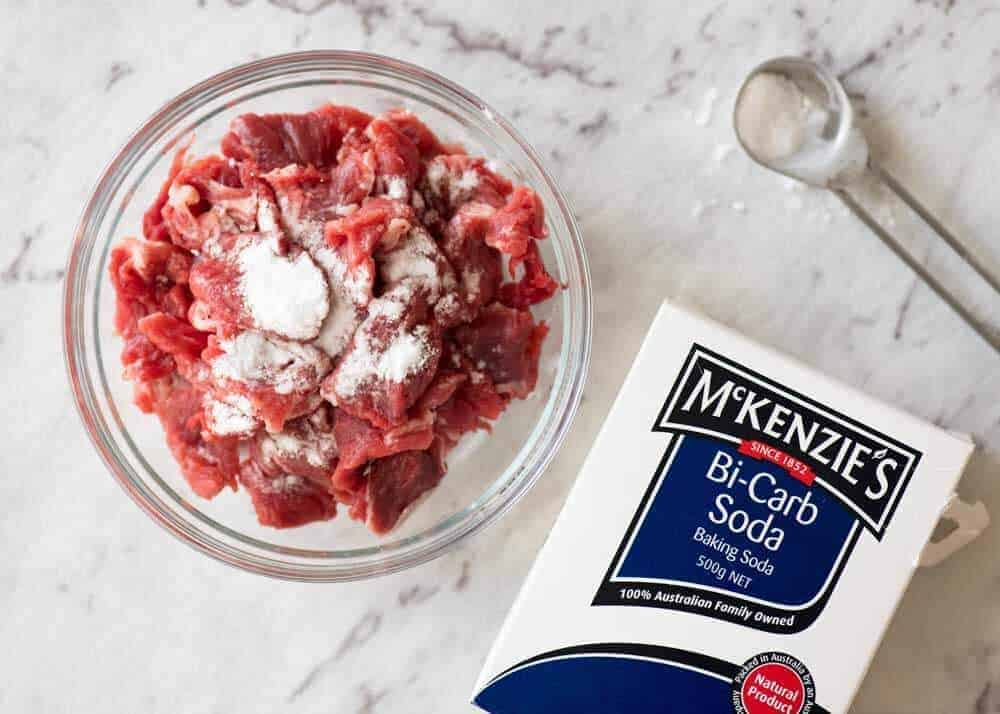

How do Chinese restaurants get their beef so tender??
Ever notice how the beef at Chinese restaurants is so incredibly tender, and how your stir fries at home are just never the same?
The secret is tenderising the meat. It’s called velveting beef.
Your cheerful local Chinese restaurant is using economical stewing beef to make stir fries with ultra tender strips of beef by tenderising it!
How to tenderise beef – easily!
There are a few methods, but this is the easiest way:
-
Sprinkle 3/4 tsp baking soda (bi-carbonate soda) on 250g / 8oz sliced economical beef cuts
-
Toss with fingers, leave for 30 minutes
-
Rinse, pat off excess water
-
Proceed with stir fry recipe. It can be marinated with wet or dry seasonings, or cooked plain. The beef will be really tender and soft, “velvet’ like. Just like in stir fries made by your favourite Chinese restaurant!
Other tenderising methods include marinating in a cornflour/cornstarch sludge then frying in oil before using in the stir fry, chemical tenderisers and egg white marinates. The baking soda method is the simplest for every day purposes and just as effective which is why it’s the method I use.

Beef cuts to tenderise
These are the best cuts of beef to tenderise:
-
economical steaks* – any type, like good value rump, porterhouse, sirloin, round bottom etc. that are otherwise quite dry when used in stir fries;
-
chuck and similar cuts of beef used for stews – this technique will tenderise the beef perfectly, however, by their very nature, stewing cuts of beef don’t have as strong a natural beef flavour as steaks. However, I’m fine with that because stir fries always have great sauces!
* It sounds counterintuitive to tenderise steaks because one would assume if beef is sold labelled as “steaks”, that indicates they’re good for quick cooking (eg grilling) so it should be good for stir fries. But it’s not – even steaks range from economical to high quality. You can use any high quality (expensive) steak in stir fries without tenderising (which is what fine dining Asian restaurants do). Use this tenderising technique on budget steaks, not expensive steaks.
Tenderising time
Tenderising time differs for different cuts of beef. Here’s the general rule of thumb I’ve come up with based on all the beef I’ve tried:
-
Chuck beef, gravy beef, oyster beef and other traditional stewing beef – 30 minutes
-
Economical steak cuts (eg. cheap rump, hanger) – 20 minutes
-
Blade, bolar blade – 40 minutes
-
Brisket – the only cut I don’t recommend, haven’t been 100% happy with outcome
If you’re unsure for your cut of beef, go for 35 minutes. Even when I under or over tenderised, it was still tender and juicy. You’ll quickly figure out the best marinating times for your preferred cuts of beef – just adjust up and down by 10 minutes at a time.
Word of caution: The beef will turn freakishly bright red. See?
Don’t be alarmed – that’s just what happens. In fact, if you put your ear very close to the beef, you’ll hear faint fizzing – that’s the baking soda at work!
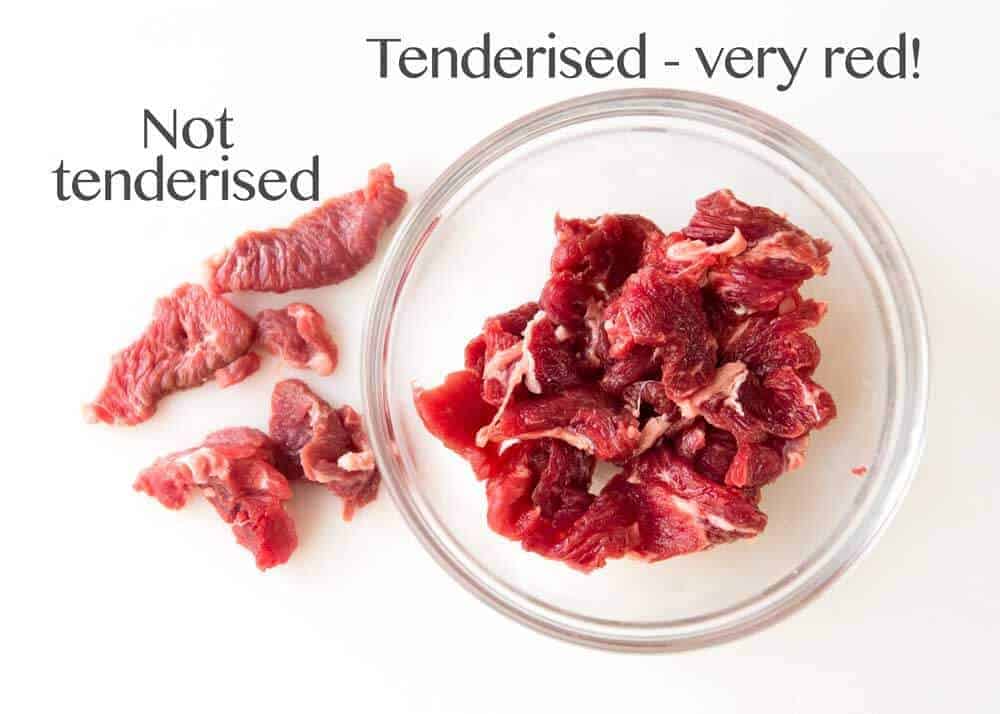
Marinating Tenderised Beef
After it’s been tenderised, go ahead and marinate it in whatever you want – wet sauce or dry seasonings. Because we’re using thin slices of beef here and it’s been tenderised, we don’t need to marinate for long. Even 10 minutes will suffice.
Also, stir fries have the benefit of glossy sauces coating the beef so that’s another reason why we do not need to marinate it for long.
Pictured below is the stir fry sauce / marinade for Chinese Beef and Broccoli.
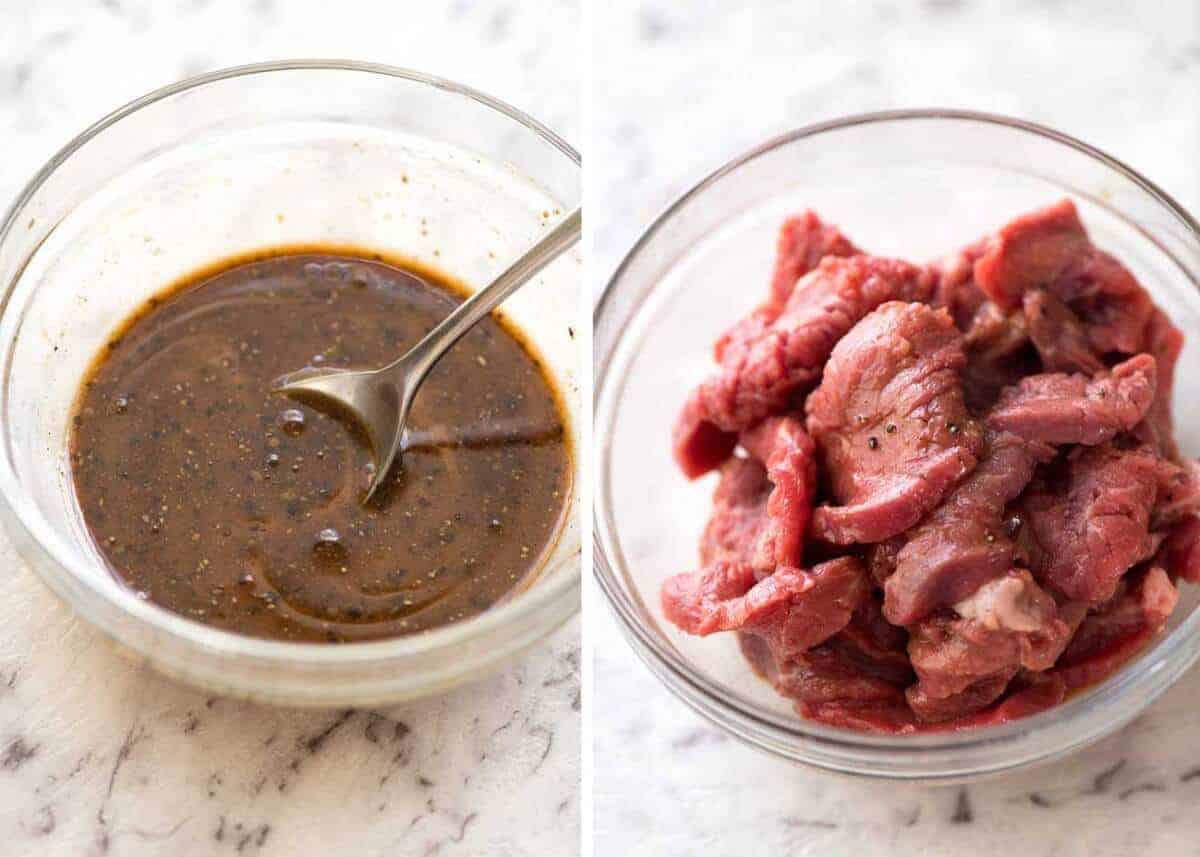
How to cook tenderised beef
Tenderised beef can be stir fried the traditional way – hard and fast on a hot stove in mere minutes – or even deep or shallow fried in oil like in this Crispy Mongolian Beef (pictured below).
Whichever way you cook it, the beef comes out much more tender and juicy than even expensive cuts of beef like beef tenderloin!
What does tenderised beef taste like?
The flavour of the beef is not affected by the tenderising. So the beef flavour will only be as good as the cut you use.
Tenderising affects the texture not the flavour of the beef. It has a “velvety” texture. The fibres are softened so you get less “meaty” texture, which is why I only use this technique to tenderise strips of meat and not cubes or steaks which would be a bit too eerie!

Why tenderise beef?
Tenderising beef enables you to make fast-cook beef recipes using economical cuts of beef that usually require slow cooking to break down the tough fibres, like in Stews. And it stays tender even if you overcook the beef!
What to make with tenderised beef
Because this is a Chinese restaurant method, I’m sharing this with stir fries like Beef and Broccoli and stir fried noodles in mind. Build your own stir fry using my All Purpose Chinese Stir Fry Sauce or Peanut Sauce for stir fries!
You can also use tenderised beef in place of chicken or pork in any of the stir fries.
But don’t limit yourself to just Chinese recipes! The plain tenderised beef isn’t flavoured, so it can be used for any recipe calling for strips of beef that are cooked quickly, such as Beef Stroganoff.
If you try this tenderising technique, I’d love to know what you think! – Nagi x
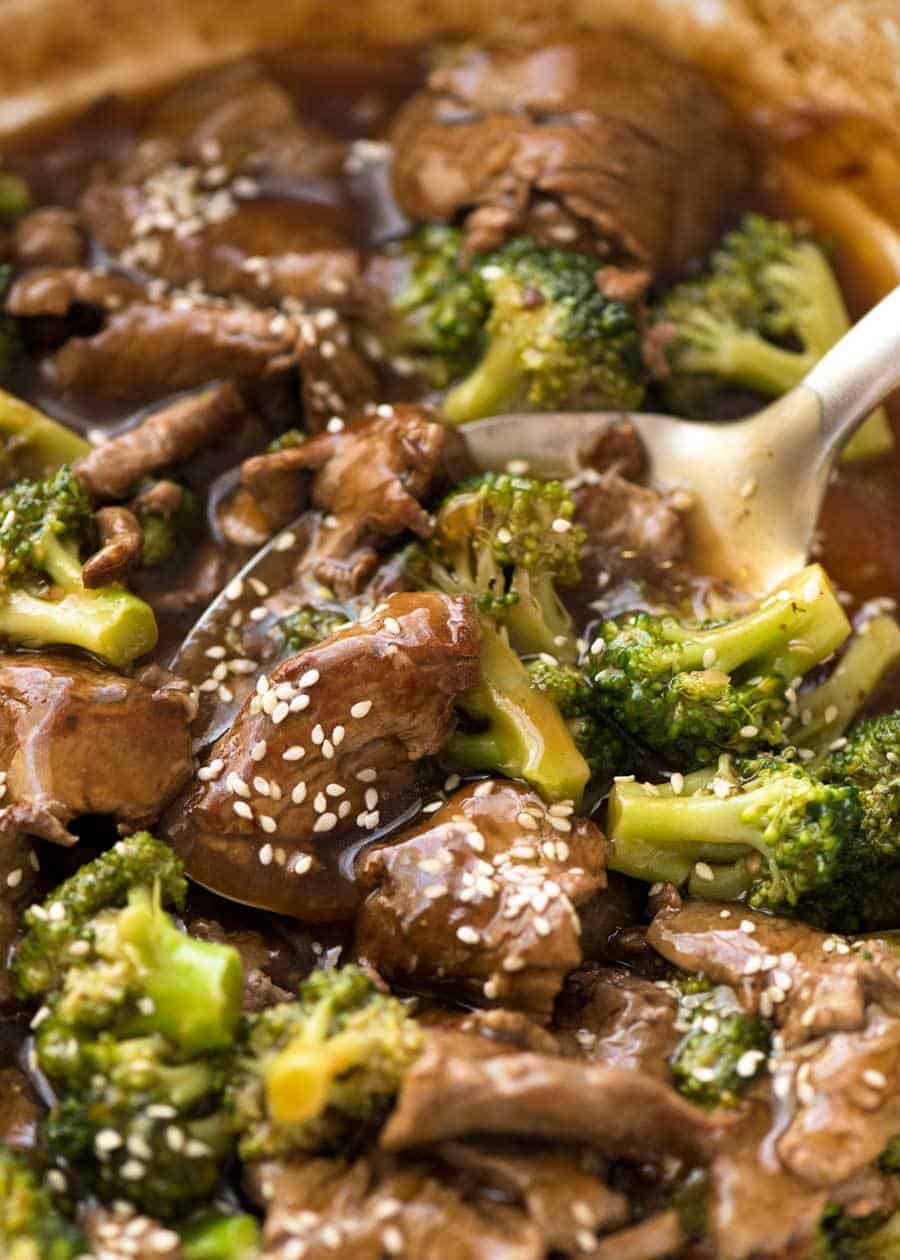
Hungry for more? Subscribe to my newsletter and follow along on Facebook, Pinterest and Instagram for all of the latest updates.
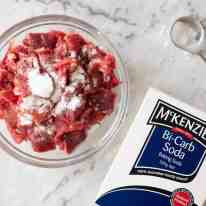
How to tenderise beef (velveting beef)
Ingredients
- 250 g / 8 oz stewing beef or other economical beef cuts (Note 1)
- 3/4 tsp baking soda / bi-carbonate soda (Note 2)
Instructions
- Slice beef thinly against the grain. (Note 3)
- Place in a bowl. Sprinkle over baking soda, toss with fingers to coat evenly.
- Refrigerate for 30 to 40 minutes. (See Note 1 for different cuts)
- Rinse beef well with tap water. Shake off excess water, then use paper towels to blot away excess water (doesn't need to be 100% dry).
- Proceed with recipe of choice. Beef can be marinated or seasoned before cooking, stir fried or deep fried, and it will be soft and tender, "velvet" like. Use for Stir Fries, Stir Fried Noodles, Beef Stroganoff and any other recipe calling for quick-cooked beef strips.
Recipe Notes:
1. Beef cuts - Use this for stewing cuts and to improve the tenderness of economical steaks. It will work with any cut of beef but is obviously wasted on expensive beef like tenderloin or high quality, well marbled fillets and rib eyes. Tenderising time differs for different cuts of beef. Here's the general rule of thumb I've come up with based on all the beef I've tried:
- Chuck beef, gravy beef, oyster beef and other traditional stewing beef - 30 minutes
- Economical steak cuts (eg. cheap rump, hanger) - 20 minutes
- Blade, bolar blade - 40 minutes
- Brisket - the only cut I don't recommend, haven't been 100% happy with outcome
Nutrition Information:
Life of Dozer
This is the only beef he’s getting today… 😂


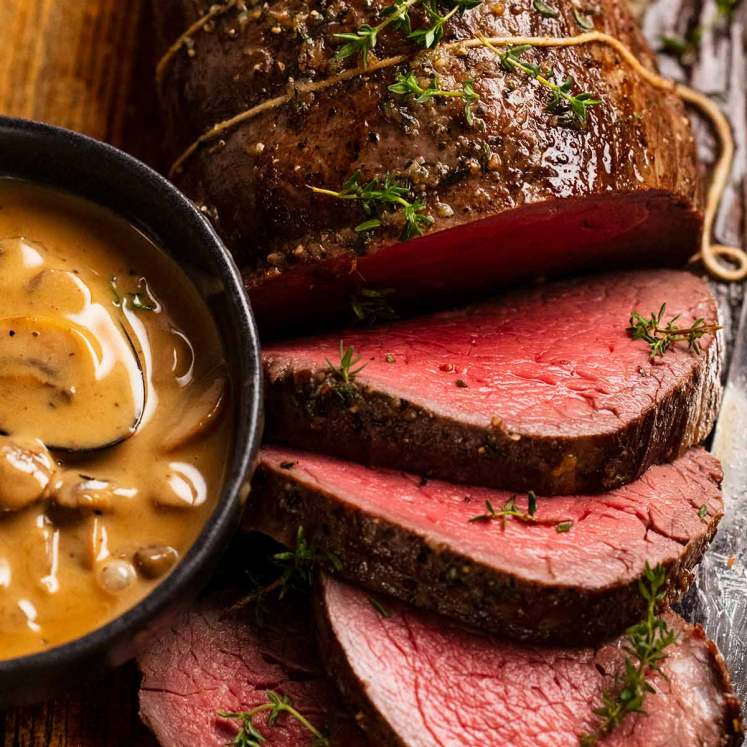
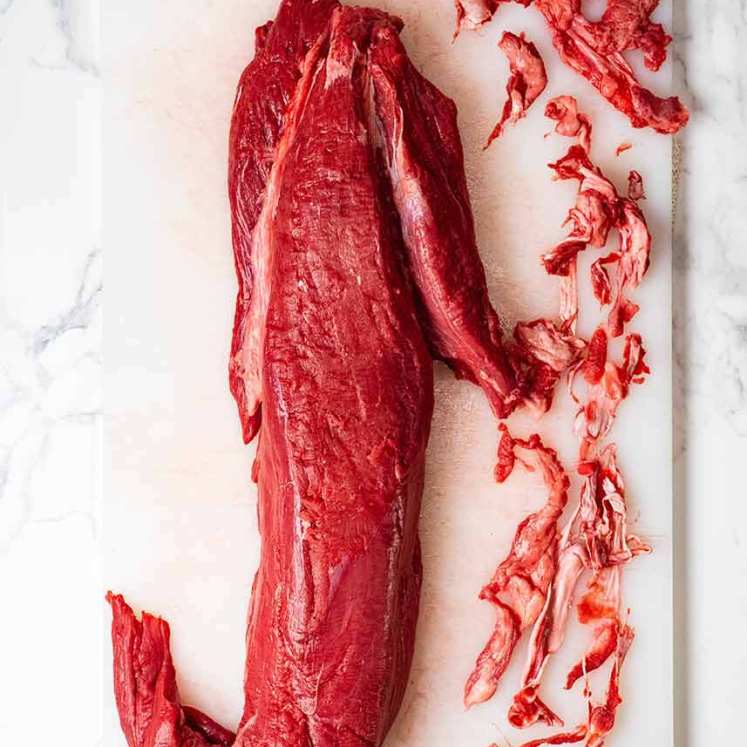

Oh my gosh! I don’t know how come I didn’t know about this technique earlier! My stir fry’s will never be the same! Thank you so much for sharing this simple technique. I paired it with your mangolia beef dish and I’m speechless. So, so, so good!!! ❤️
I wonder whether the baking soda way can be used on chuck of beef before slicing them so that later the washing of the beef will not diminish the any nutrients from the beef.
Hi Mel, the meat needs to be sliced before velveting as using big pieces won’t absorb and be tender the whole way through. Velveting does not affect the food whatsoever and won’t diminish your beef. N x
Hi, is this something that can be done with mince, as you wouldn’t be able to rinse it out? Especially minced pork, as I find that the taste and smell of minced pork is quite strong when used making wonton.
Thank you so much Nagi. I have been wondering how to tenderise beef to stir fry.
I use the velveting method for chicken which also stops it from drying out when cooked.
I’m definitely excited to try your honey and black pepper sauce and this technique! My fiance loves Asian food so I try to prepare different recipes when I stumble across them.
Is there a recipe for Asian broccoli, I’m not sure if there’s a name for it, the kind you’ll find on buffet and in takeout?
I’m planning on serving this with rice and a mix veg: carrot, broccoli, mushrooms. Any suggestions would be fabulous!
Hi Rose, I hope you love it! I believe this is the recipe you’re looking for https://www.recipetineats.com/chinese-broccoli-with-oyster-sauce/ N x
Both recipes turned out fabulous.
Yes, there was a slightly fishy/sour smell but a very mindful rinse got rid of it.
I rinsed mine like I wash rice.
My fiance literally inhaled his bowl then flipped it over trying to find more. So I call both a keeper!
Thank you for the broccoli recipe I’ll try it this week and report back.
Would this also work on stir fry cut beef strips from the supermarket? I find when I cook them they get tough VERY quickly…
Hi Sarah, yes it will! It will totally transform your cooking! N x
I used this method a few weeks back and my meat absolutely stank like off fish so I chucked it out. Tried it again and sniffed the meat first before putting bicarb on. Same result – stinky meat. I’m still going to eat it this time because I assume it’s just the bicarb causing the smell! It was fine before I mixed it in. So strange. Haven’t cooked it yet so not sure how it will go.
The same happened to me! The first time I tried with chicken and everything was A-Okay. But the bicarb made my beef steak smelled REALLY pungent. I rinsed and pat dry after the tenderising process. And the meat was freshly bought from the butcher, so idk where I did wrong.
Did you rinse the meat?
Hi Jess, I can honestly say I haven’t noticed this ever before!!! N x
Nagi, this has just been fantastic for me. I’ve used this for yummy stir fries. I decided to I try this tonight with a beef tips and gravy recipe that wasn’t even stir fried with stewing beef. My husband devoured it all! This is such a great technique to use for any tough cut of beef recipe even when it’s not a not a stir fry. I was nervous about trying it for this recipe but it was FANTASTIC! We have no left overs for lunch. I think that I will try it with pot roast too. Thanks again for teaching me something new. Hi to Dozer.
This tenderizing method worked very well. My husband was surprised. Thank you for sharing, I will use this method from now on. Thank you.
Amazing results , perfect melt in your mouth beef…. Brilliant..
Worked great for stir fry. My son sliced thin pieces from a roast (raw) to make fast fry steaks for his breakfast wraps. He velveted the steaks and they were very tender. Also used your chicken velveting recipe – chicken was just like Chinese restaurant take-out! Everyone noticed the difference. I love your site and use many of your recipes.
I just did this with chicken. I only let it sit about 5 minutes. The chicken was very tender but had a fishy taste to me. My son said the same but my daughter and husband thought it tasted fine.
Sorry meant that reply for the comment right below that mentioned the fishy smell.
I didn’t get any fishy taste from either beef or chicken. Did you remember to rinse the meat?
Hi Nagi,
I’m trying this for the second time because it didn’t work for me last time. Both times, the beef has smelled “fishy”. Is that normal?
Same thing happened here, I bought a large rump steak (for your honey and black pepper beef recipe) sliced beef into thin strips and sprinkled with bicarb, tossed it through then placed in fridge for 30 min, took it out and noticed the meat smelled off, paper towel dried it and the paper towel stunk really off! so then I wasn’t sure if the meat was maybe off to begin with (it didn’t smell when I was slicing it) or if it was a result of the baking soda! I read that tenderising using this method will alkaline the meat, could that cause a smell? But I am loveing your recipes Nagi, you’re my inspiration to try many new things!
Hi Ari! I’ve done a lot of research around this and don’t believe that the bicarb is the problem. I am thinking – is it possible that the beef was being sold at a good value because it was a bit iffy? I know that cheap steaks at local supermarkets aren’t the best – especially if they were vac packed (then yes, they smell a bit off even if they are not. That’s what happens with vac packing). I hope that helps! N x
I’ve been served steak in a restaurant more than once, that smelled bad. Researched and found out that some people bleach the meat if it’s just on the verge of going bad.😨 Grocery stores might di this too.
Hi Spencer, I’ve never had this issue – can I ask what cut you’re using? N x
Great method of tenderising, but it can leave a slight soapy taste as the bicarb reacts with fat in the meat to turn some of into a soap like compound (which is what soap actually is, fat+alkali). The way to get rid of that is to stir in a quarter of a cup of white vinegar to neutralise any remaining alkali from the bicarb. Then thoroughly rinse off. The vinegar isn’t to add flavour, it just removes any soapy taste.
Sorry should mention that you add the vinegar AFTER you have used the bicarb, and rinsed it off. Please feel free to edit my first post.
Thank you! I am friendly with the owner of a pan-Asian restaurant across from where I work. The beef is always meltingly tender, and one day I asked him about it, and he said baking soda! I couldn’t believe it. Thanks for sharing this recipe so I could try it. I will report back soon. And as for the reviewer who has tried 100s of Chinese restaurants, I find it difficult that all of them served tough beef. Maybe instead of the definition of insanity, try chicken, shrimp, tofu, something else to your liking? Or like another reviewer said, try this recipe?
That’s why we’re here, isn’t it? Just a thought.
Yes! 100% Jessica! 🙌 I hope you give this one a shot and love it! N x
You say “have you ever noticed how tender the beef at a Chinese restaurant is so incredibly tender”. I have eaten at over a hundred Chinese restaurants and takeaways and always the beef is extremely tough. The toughest beef I have ever tasted. Also I tried to post a comment criticising that comment on tender beef that you made and it was blocked. It seems that no critical comments of you are allowed. Only praise is allowed!
Hi William, I certainly accept critical comments – I encourage all types of feedback! Sounds like your local takeouts don’t practice the tenderising technique – and maybe they should if it’s that tough! I hope you try this technique, maybe you can teach your local a thing or two 😉
You say “have you ever noticed how tender the beef at a Chinese restaurant is so incredibly tender”. I am sure you must be a comedian. I have eaten at hundreds of Chinese restaurants and takeaways and always the beef is as tough as old boots!
Might help if you put your teeth in.
“ALWAYS as tough as old boots” “the beef is extremely tough ALWAYS””toughest beef I have ever tasted”…then why ALWAYS go back to “HUNDREDS of Chinese restaurants and takeaways”.The real comedian here is obviously the one who numerous times pay for old tough boots to eat then complain when they get offered genius tips on how to soften those “tough boots” at home.We all have different experiences at restaurants no need to be so sour about it though!
Hi Nagi, can I use this method for beef sirloin for making your beef stew? Thank you
Hi Sin Yee, you wont need to tenderise for the beef stew – it’s cooked long enough that the meat will be super tender 🙂 N x
Hi Nagi, thanks for sharing your recipes. Can I tenderize pork too
Hi Bev – yes, I actually mention this in this blog post 🙂
Can I use the bicarb, then marinate then freeze to be used later?
Hi Gayle! I haven’t actually tried that – but now I’m curious so I will and will report back! N x
Thanks Nagi. I’ll definitely try this. I have steered away from beef stir frys because the beef being too chewy.
Love all your recipes. The videos are great too.
This will totally change your life! N x